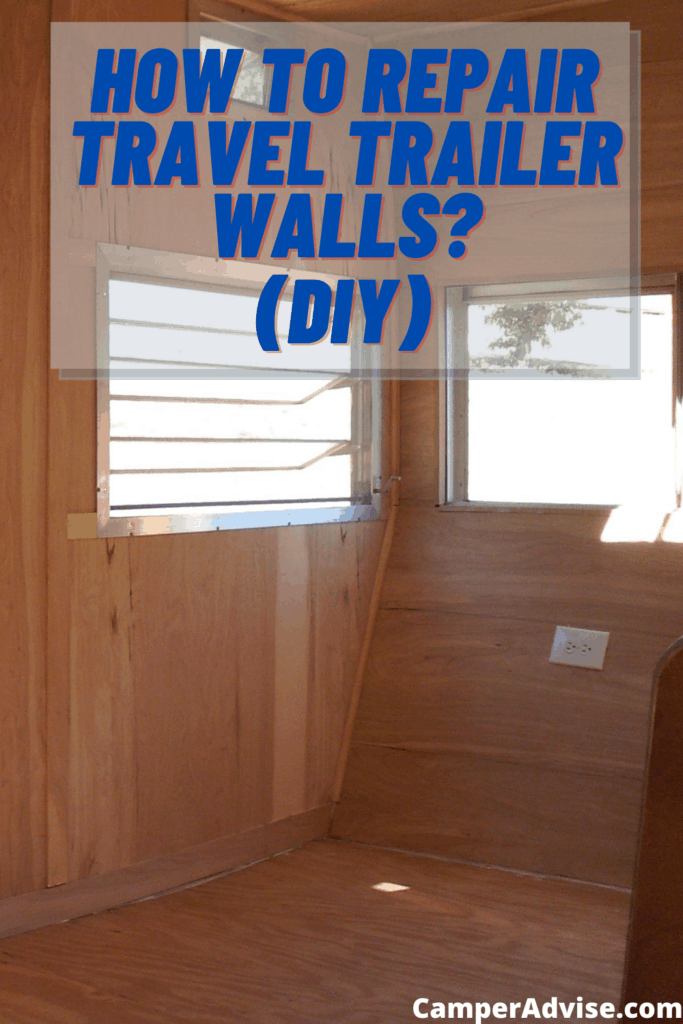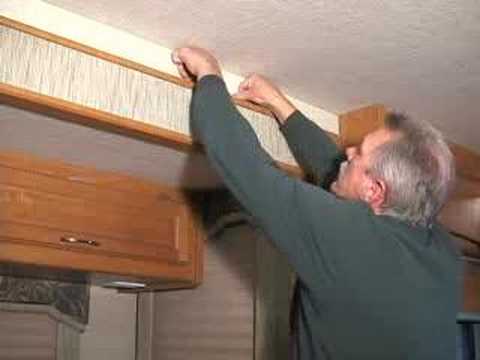Last Updated on December 12, 2020 by Ted Mosby
Whether it is small or big, your travel trailer is a significant investment, and taking care of it is your responsibility. Regardless of how minor the problems are, you cannot afford to overlook them at all.
Paying close attention to minor issues and repairing them on time will also help to prevent more significant problems while also avoiding higher costs. Below, I will share some tips to repair travel trailer walls that you can do yourself.
If you are ready, let’s start and learn how to repair travel trailer walls DIY!
How to Repair Travel Trailer Walls?
Below is a detailed step-by-step guide on how to repair travel trailer walls. You should also know that repairing travel trailer walls is a simple job, and anybody with the right tools and time can tackle it. So, let’s get started!
1. Inspecting the Damaged Wall
Before you start with the demolition process, it is necessary to figure out which part of the trailer walls requires attention. In this regard, the best way to inspect to find damp spots around the edges of panels. If you see wet spots, it means there is a high chance for black mold and hazardous bacteria growth.
You will need some tools to address and fix the problem, such as a hammer, pry bar, saw, metal shears, putty knife, screwdriver, electrical tape, and paint.
Once you have the necessary supplies ready with you, follow the steps below,
2. Clearing Carpet and Paneling
Like any other repair task, the first step is to remove carpets and paneling. Some places might display wear, but some also require you to take a closer look. When clearing, pay attention to joining woods to determine if it needs to be repaired or not. The best way is to start from the ceiling all the way down to the floor.
If your trailer has fiberglass walls, you should pay attention to repair insulation as well. There is a foam insulation layer between fiberglass and metal coating. While opening the wall, if the insulation is damaged, it would be time to address the issue. A newer fabric insulation fix is to get cellulose-based foam sprayed on the walls.
Camping Gear SALE!
We have teamed up with Ape Survival to give you a huge 25% off EVERYTHING on their store! They have camping gear, hiking gear, survival gear and much more, all at 25% off when you click the link below.
SHOP NOW3. Circumvent Obstructions
When you are done with clearing, make sure to move wiring or plumbing that you think might obstruct you from accessing your work area. Almost all the travel trailer walls have plumbing and wiring systems running throughout the trailer. Moreover, almost all the new models come with a series of flexible plumbing and plastic tubing.
This means these campers have a flexible design. Since there are plastic pipes, it will be easy for you to redo the entire camper layout.
4. Sealing to Keep the Moisture Out
The primary disadvantage that travel trailer walls have is paneling and particleboard. There is an excellent chance that the cheaper particle board wall will collapse after a few bouts with snow. Once you have figured out the flaw, the use of an epoxy sealant is helpful to keep the moisture out.
Applying the sealant to joints and edges will eliminate airborne agents from sneaking into the sleeping area. However, there are various types of sealers made explicitly for the walls of the camper. Most older model campers have corrugated metal walls. If you have a trailer with corrugated metal walls, it is vital to get an appropriate epoxy sealant.
How to Repair Water Damage in Travel Trailer?
Another common problem with travel trailers is water damage. However, finding water damage is a simple job. The typical spots to find water damage are around the joint or near a hole punctured. If you have found a few small spots or mold, there’s nothing to worry about.
What you have to look for is the significant sections that might cost you serious money, and if you overlook them, you will not be able to fix the trailer. If you are facing a water damage issue, here is how to repair it.
1. Look for Stains
It is vital to find the root of the issue before you start the repairing process. Staining is the way that lets you find the leaks. When water finds a way to seeps in through cracks or seams, it will leave stains. If you have found a black or brown stain, it means there is a leak in that area. Moreover, remember that water stains will be in most water usage or plumbing parts.
2. Check for Mold
While checking for stains, they leave a discoloring effect on the carpet or insulation near that area. Inspecting the level of discoloration is the way to gauge the extent of the damage. If you see the light brown color, it means the area doesn’t have any moisture. So, what you’ve to look for are black wet spots.
Remember that if you find the area covered with black mold or moisture, make sure to cover your eyes and face. The best way to remove black is to use bleach and soap.
3. Look for Further Water Damage
Once you are finished cleaning the inside area, it’s time to examine the undercarriage to check for any further water damage. The easiest way to inspect the water undercarriage is the bolts securing the edge. They are easy to find and help you determine if something is wrong going on inside the trailer walls.
Camping Gear SALE!
We have teamed up with Ape Survival to give you a huge 25% off EVERYTHING on their store! They have camping gear, hiking gear, survival gear and much more, all at 25% off when you click the link below.
SHOP NOWRemove the screws to inspect the area. If the screws are clean, it means the camper’s interior walls have no leakage or holes. However, if you see rust on the screws, it means there is some leakage that you have to fix.
How to Repair Travel Trailer Wall Delamination?
The common problem that older model travel trailers have is wall delamination. It is a severe issue that needs to be addressed as soon as possible.
So, what is delamination?
It is a term used for the trailer walls layers when they start to breakdown. Travel trailer walls are usually constructed by gluing pieces of board and insulation together. These layers usually consist of three to seven sheets.
These layers include,
- Luan: It is a thin plywood sheet made from tropical hardwood. Usually, this sheet is used to make small tools and dollhouses.
- Styrofoam: Styrofoam is the second layer and glued to the Luan sheet. It is about two or three inches thick and used for insulation. It is made from different types of polystyrene.
- Wood Paneling: The third layer is wood paneling. Wood paneling is used in almost all the trailers across the country. These are thin sheets and made from different types of wood products. They are generally used for the interior of the trailer. Since there are different types of indoor and outdoor wood panels, make sure to get the appropriate one when buying.
- Gel Coat: Gel Coat is the outermost layer of camper walls. It is a form of a weather-resistant gel. Despite being called a gel, it is a fiberglass material covered with a coating to support siding withstand in extreme weather conditions.
So, now let’s talk about how to repair the travel trailer wall delamination?
Here is what you will need,
- Epoxy Resin & Hardener.
- Plastic Tubing.
- Plastic Syringes.
- Mixing Cups.
- Clamps.
- Plastic Sheeting.
- Rubber Gloves.
- Other basic tools.
Once you have all the supplies listed, you are ready to start the process.
1. Finding the Delaminated Areas
Find and inspect the delaminated areas to assess the extent of the damage. If you have found more areas that need to be treated separately, it would be great to treat smaller areas first.
2. Using the Painter Tape
Once you’ve found the areas that need treatment, mark them using the painter tape. It will help to determine which areas are delaminated later.
3. Accessing the Delaminated Panel(s)
You will be required to take off trim, edging, and compartment doors to access the area behind a delaminated panel(s). You may find multiple layers delaminated. Inspect each layer to determine where you need to use an epoxy injector.
4. Mixing Epoxy
Now, you are required to mix the epoxy with hardener. Once you have mixed it, load the injector with the material.
5. Injecting the Epoxy into the Delaminated Area
For injecting the epoxy into the delaminated area, press the syringe and then slowly pull it out. Once you have pulled the injector out, immediately press down the treated part. After that, apply the clamp to the treated area.
Repeat this process for all the delaminated area to repair travel trailer walls. Once completed, reinstall panels, trims, windows, and doors that you have removed at the start of the process.
How to Insulate Travel Trailer Walls?
When you consider insulating a travel trailer, there are many factors to know about to protect your camper before starting the insulation process. You want to know about different insulation ideas, including the cost, the type of material, and of course, how long it will last.
Below are a few types of travel trailer insulations!
1. Fiberglass Travel Trailer Insulation
Fiberglass insulation is the most popular type of insulation, which comes standard in most travel trailers. It has an incredibly high R-value, which means it offers greater protection to protect your rig from extreme weather. Moreover, it is also easy enough to install and among inexpensive options.
However, you should remember that it wears out quickly and more sensitive to moisture damage as compared to other materials. The R-value is decreased when the insulation gets wet. It is a good pick if you don’t mind replacing the insulation more often.
2. Spray Foam Insulation
Another popular travel trailer insulation is Spray Foam. It is also easy enough to install. You load the spray foam in an applicator to directly spray it to your travel trailer walls. Spraying the foam evenly throughout the travel trailer walls means it will serve as an airtight barrier between inside and outside.
However, unlike fiberglass insulation, it doesn’t come standard, so you have to install it DIY. It is also incredibly lightweight.
3. Rigid Foam Travel Trailer Insulation
Rigid Foam insulation is highly durable and has a longer lifespan. It is incredibly resistant to moisture as well. It is a good pick if you travel in different climates or spend more time in humid weather conditions. It comes in different thickness boards and can be adjusted to any place by cutting it off.
Like spray foam insulation, it also doesn’t come standard with travel trailers, so you have to install it DIY. Moreover, it is also more expensive than both fiberglass and spray foam insulation. The best thing about rigid foam insulation is once you have installed it, you don’t have to worry about the insulation for a long time.
Wrapping Up
That is how to repair travel trailer walls DIY. I have outlined all the steps in detail, so it should not be hard for you to repair your trailer walls. Moreover, although your trailer is not a four-season trailer, you can insulate it to stretch your travel season. I have listed the best insulations for a travel trailer that you can go for to keep your rig protected against any kind of weather.
FAQs
How much time does it take to repair travel trailer walls?
Repairing travel trailer walls is not an arduous task if you follow the steps mentioned above. It could be done in approximately 12 hours.
Table of Contents


